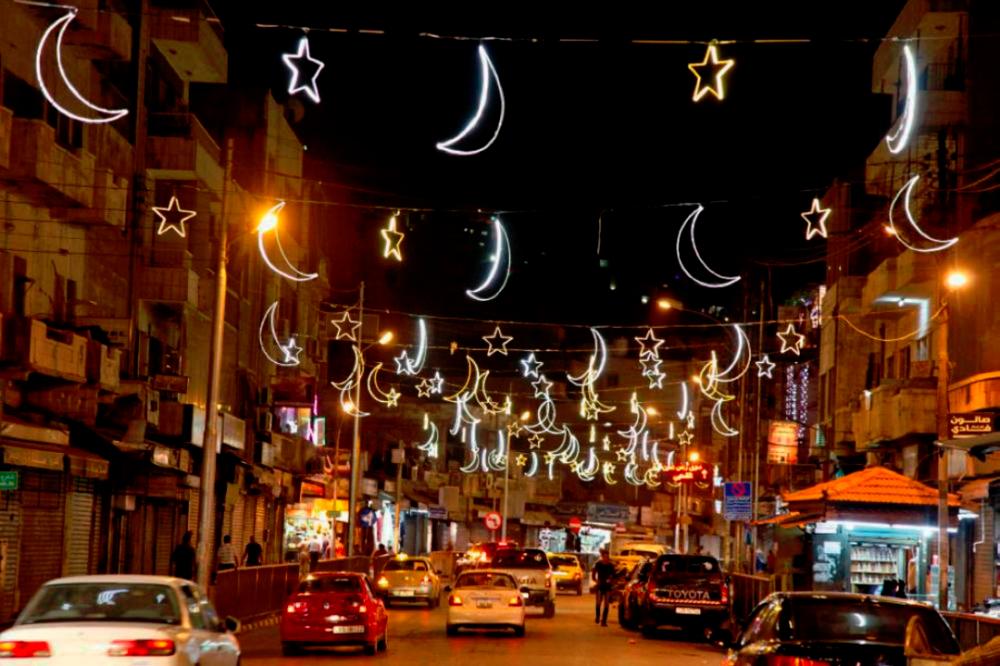AMMAN: The start of Ramadan Al Mubarak in Jordan on Sunday was celebrated by its citizens with joy and happiness.
Houses, alleys, roads and mosques, whether in towns or villages, are decorated with the ‘Fanous’ or traditional lanterns in various colours, shapes and sizes. Various institutes and charitable organisations rush to set up Ramadan tents to provide breaking meals to the needy.
A local woman, Umm Ali Al-Bitawi, described Ramadan as a month of worship that comes with rituals, customs and traditions of one’s ancestral heritage.
“It (the heritage) is in the form of social, the religious; or special dishes that is served during the breaking of fast”, she said when met by Qatar News Agency (QNA).
“Among the most anticipated is the practice of ‘Musakabah’. Although it is still practiced until now, it is not as lively as before,“ she said.
The tradition of ‘Musakabah’ or literally ‘serving each other’ is like the practice of pouring a drink for each other or serving food shared among neighbours during the month of Ramadan.
“And it’s all because of the ‘open buffet’”, she said in jest, adding that it is never a constraint – as the purpose is to increase closeness, love and unity.
Umm Ali, in recalling her memories, explained that while the husbands and men go to the mosque to pray, women would usually go to the houses of neighbours or relatives.
“Now, the whole family goes out by car on the night of Ramadan to head to the streets and popular cafes; or just stay at home, facing the television screen”, she said, adding that the iftar (breaking of the fast) and sahur meals have also changed with the times.
In the past, a few dates, tomatoes, ‘Rashoof’ soup or dhal bean gravy, along with ‘Lazakiyat’ and ‘Al-Mutabaq’ (both a type of Arabic bread or pastry) used to be enough to complete the iftar. “Easy and cheap,“ said Umm Ali.
Now, she said Ramadan tables are filled with various types of food, and that water and dates are usually consumed before Maghrib prayers.
It is after the prayers that the ‘main event’ (main meal) begins, starting with a soup which usually consists of fresh vegetables and ‘Shu-‘airia’ (like vermicelli), as well as a variety of salads. The main course is usually rice with meat, in addition to some other appetizers such as ‘Fatteh Hummus’ with minced meat and pickles; followed by ‘Musakhan’, which is a flat bread served with caramelised onions and sumac fried chicken.
Touching on iftar dishes, Umm Ali explained that Jordanians always preserve the diversity of their traditional food.
“In every house, there will definitely be one such (traditional) dish. Perhaps the most prominent ones are ‘Maqlouba’, ‘Mansaf’, ‘Musakhan’ Chicken, ‘Maftoul’, ‘Mahashi’, and many more traditional dishes ”, she said.
Umm Ali stressed that the practice of ‘Al-Masharati’ is still the most prominent activity during the month of Ramadan in Jordan.
‘Al-Masharati’ is a traditional practice conducted by a group of men appointed by the neighbourhood head or the imam of a mosque to to wake people up at dawn, using old drums. Every night, they walk down the alleys and paths of the housing estate, beating the drums, and often accompanied by several children chanting: ‘La ila ha iIlallah... Wake up, O sleeper’. During the last days of Ramadan, the usual ‘Al-Masharati’ group will chant some words of farewell to mark the nearing of the holy month’s end.
Meanwhile, Ziyad Al-Nashef (a resident of the city of Amman) told QNA that he and his family usually decorate their homes a week before the arrival of Ramadan.
“It has become a seasonal joy, especially for children,“ he said.
One of the customs involve children buying ‘Fanous’ and flashing lights of various shapes with pocket money given to them to be hung to decorate neighborhood alleys and residential buildings. The colorful refraction of the ‘Fanous’ lamp is very attractive and beautiful, especially at night.
For Ahmed Al-Waqfi, he praised the practice of setting up the Ramadan tent which becomes the focus of many people after the Tarawih prayers.
“There are dates, Arabic coffee and Ramadan juice ... there are ‘Qatayef’ and ‘Awamah’ as well”, he said.
Ramadan tents are also used for the preparation of ‘iftar jamaie’ (breaking of fast in large numbers), serving a variety of food sponsored by philanthropists for the homeless, the poor, widows and orphans.
Earlier, the Government of Jordan announced the launch of the ‘Ramadaniyat’ campaign, comprising sports, cultural, tourism and social events during the holy month of Ramadan.
The campaign, which aims to revive the traditions of Ramadan, was held in collaboration with several ministries – including the Ministry of Tourism and Antiquities, the Ministry of Youth, and the Ministry of Social Development.
It is also an effort to highlight Jordan’s cultural products, in addition to preserving the heritage to ensure its availability to the new generations. - Bernama









